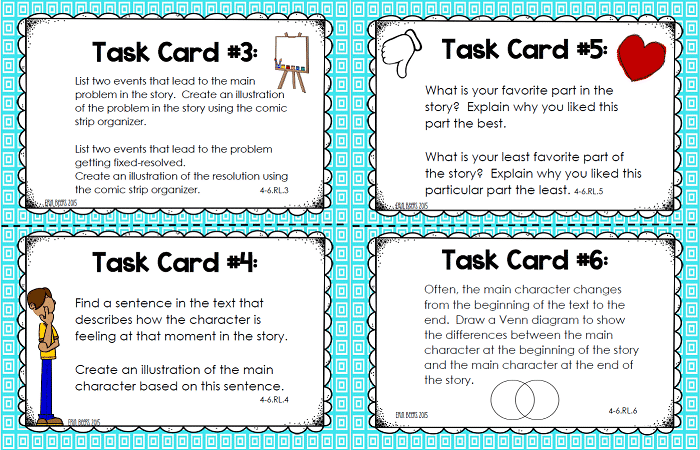Middle school reading teachers like me are always on the hunt for resources to motivate students while allowing for differentiated instruction. I find that I am always in need of teaching tools that are engaging and motivating, capable of being used in a literacy center, incorporated into Daily 5 instruction, and can be utilized with minimal prep time on my end.
I have found task cards to be one of these flexible and multi-purpose resources. They are a perfect way to be able to reinforce a concept and meet all student instructional needs. If you are looking for a primer on task cards and their many different types, check out this post. For now, here is a peek into how I have found them to be most effective with reading and literature instruction.
PREP…
First, print them on cardstock and have your classroom helpers cut and sort them. There are always a few students I can rely on for projects like this each school year. Pass this job along to those students who like to come in early, stay in for recess, or spend a little extra time with you in your classroom.
While there is not a ton of prep in organizing these for classroom use, students love to be put to work and help out. After they prep the task cards for you, be sure to laminate them so they can be reused.

TYPES OF READING TASK CARDS
Task cards are an easy tool to incorporate into your classroom any day. I have three sets that you can grab and start using immediately to enforce literature reading skills and vocabulary.
These Character Analysis Task Cards are perfect for deepening student understanding of how characters are feeling based on information that is shared in the text. These cards have a mini lesson and allow students to support their understanding of the different feelings of characters with evidence. Understanding characters can be a bit complex, and I need my students to tell me more than just that a character might be feeling “sad.” I need to know why they are feeling sad and what information from the text made them arrive at this conclusion.
I created my Reading Literature Task Card Tool Kit because I LOVE reading novels with my students. We often tackle whole-class novels in order for students to learn the literature standards. At the end of novels, I want to see what my students have learned, and in addition to an end-of-book project, we reinforce what we have learned using these reading literature task cards.
There are 8-half page cards that students can focus on and utilize the student answer document to show what they know. Simply read a fiction text, print these cards out, laminate, and watch your students’ understanding of the text come alive.
My Context Clue Task Cards were created because vocabulary is a challenge for so many of my 6th graders and it is something I am ALWAYS working on helping them develop. I can speak to them all day using colorful words and while this is beneficial, at the end of the day, they need to be able to read the vocabulary and make sense of the 6th grade level and above text they are to be reading.
This resource includes 84-multiple choice task cards that provide some focused practice with using context clues to identify the meaning of unknown words. It is perfect if you are finding that your students could use some additional practice with this word work reading skill.
WAYS TO USE READING TASK CARDS
- Literature Circles or Book Clubs
Divide the class into small groups, and assign each group a set of task cards that focus on different aspects of the literature they are reading. These can range from character analysis, theme exploration, setting descriptions, and plot development. - Reading Centers
Set up various stations around the classroom, each dedicated to a different literature standard or skill, such as vocabulary, inference, or summarizing. At each station, provide a set of task cards related to that skill. - Scoot Activity
Place task cards on desks or around the room. Students start at a card, respond to the question or prompt, and then “scoot” to the next card when time is up. - Exit Tickets
Use task cards as exit tickets. At the end of the lesson, give each student a task card that reviews a standard covered that day. Students write their answers on a piece of paper and hand it in as they leave. - Guided Reading Groups
During guided reading sessions, use task cards to focus discussion and analysis. Each card can target a specific element of the text being read. - Interactive Notebooks
Students can attach task cards to their interactive notebooks and write their responses beneath them. This method integrates the task cards directly into their learning portfolios, making for a great review tool and a way to track progress over time. - Writing Prompts
Use task cards as writing prompts. For example, a card might ask students to write from the perspective of a character or to create an alternate ending to a story. This encourages creative thinking and helps students practice narrative writing in an engaging way.
I hope you have found some helpful tips and resources for immediate implementation with your students!







